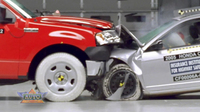SUVs and Pickups Becoming Safer Than Cars and Vans, According to New Crash Test Results +VIDEO
EFFORT TO MAKE SUVS, PICKUPS LESS DEADLY TO CAR OCCUPANTS IN CRASHES IS PAYING OFF
• SEE ALSO: TACH's New Vehicle Buyers Guide
NEW YORK - September 28, 2011: Today's SUVs and pickups pose far less risk to people in cars and minivans than previous generations, a new study from the Insurance Institute for Highway Safety shows. Until recently, SUVs and pickups were more likely than cars or minivans of the same weight to be involved in crashes that killed occupants of other cars or minivans. That's no longer the case for SUVs, and for pickups the higher risk is much less pronounced than it had been.
For example, among 1-4-year-old vehicles weighing 3,000-3,499 pounds, SUVs were involved in crashes that killed car/minivan occupants at a rate of 44 deaths per million registered vehicle years in 2000-01. That rate dropped by nearly two-thirds to 16 in 2008-09. In comparison, cars and minivans in the same weight category were involved in the deaths of other car/minivan occupants at a slightly higher rate of 17 per million in 2008-09. The researchers attribute much of the change to two things: improved crash protection in the cars and minivans, thanks to side airbags and stronger structures, and newer designs of SUVs and pickups that align their front-end energy-absorbing structures with those of cars.
Watch the video news release
Lifesaving cooperation: The more compatible designs are the result of efforts by automakers, the government, and the Institute to address the problem of mismatched vehicles. The National Highway Traffic Safety Administration asked automakers to address the compatibility issue amid concern about the changing vehicle mix on U.S. roads. In response, the Alliance of Automobile Manufacturers, the Association of Global Automakers, and the Institute led a series of meetings in 2003 to come up with solutions. Participating automakers included BMW, Chrysler, Ford, General Motors, Honda, Hyundai, Isuzu, Kia, Mazda, Mercedes, Mitsubishi, Nissan, Subaru, Suzuki, Toyota, and Volkswagen.
The companies agreed to build the front ends of SUVs and pickups so that their energy-absorbing structures would line up better with those of cars, reducing the likelihood that an SUV or pickup would override a car in a collision. Better alignment allows both vehicles' front ends to manage the crash energy, helping to keep it away from the occupant compartments. The automakers also pledged to strengthen head protection in all vehicles in order to improve outcomes when an SUV or pickup strikes another vehicle in the side. They accomplished this by installing more head-protecting side airbags.
For additional information visit www.iihs.org



